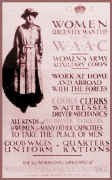Why Did the Women Dress Different in 1920

1914-1920 Towards Dress Reform
Fashion History
By Pauline Weston Thomas for Fashion-Era.com

Towards Dress Reform - Womens Fashion History 1914-18
-
Dress Reform 1905 1915
-
1914 Underwear and the First Patented Bra
-
Hair
-
The Tango Craze
-
Clothes Styles During the First World War 1914-1918
-
Women and War Work
-
National Standard Dress
Dress Reform 1905-1915
In fashion history terms time never stands still. In the Edwardian era, new influences and a changing society in a young century began to challenge the stiff formality that prevailed. In the years between 1905 and 1918 clothing styles emerged that were evolutionary in bridging the gap between the rigid formality of the Edwardian styles and the ultimate changes that led to the knee high dresses of 1926.
Oriental influences have been shown in fashion history in women's dress in other eras such as in the 1800s, the mid 1920s and later in the 1970s and 1990s. It was in total contrast to the prevailing mood of dreamy pastels favoured by high society when hot tropical colours and a new silhouette was introduced.
In 1920s fashion history, the initial break with the traditional styles stemmed from the inspiration drawn from the Aesthetic and Rational Dress Reform Movements of the late 19th century. Exciting theatrical costume designs which broke the rules also paved the way for more relaxed dressing. This was all fast forwarded during the war years and led to the major changes in construction of clothes and undergarments for the remainder of the century.
This era from 1905 to 1915 was particularly important in eroding attitudes to dress which had been stuck in the rigidity of the Victorian era for too long. Barriers broken in this period laid the foundations for the more relaxed clothes of the 1920s.
1914 Underwear and the First Patented Bra
The fashions of the era needed a new approach to under foundations. The first bra was patented in 1914 by Mary Jacobs an American. It is not thought to be the first bra ever, but it is the patented record that gives her the credit. Cretan women had the idea long before and various BBs or Bust Bodices or improvers had been around in Britain and France since the Edwardian era and exist today in costume collections.
Several designers including Paul Poiret, Lucille and Vionnet all say they invented the bra as correct underwear for their new dress innovations and admonished clients to abandon their corsets. We will never truly know. What is certain is that a bodice designed separately from the corset had become usual wear by 1905 and Mary Jacobs had the intelligence to patent a design for a bra.
Hair
Many women had begun to cut their hair when doing war work for practical reasons. A compromise between long and short tresses was 'Curtain' hair and was favoured by the genteel. Worn with a band it could be dressed more prettily with a feather at night. Colouring the hair with Henna was popular as it was less risky than using the unreliable chemical dyes of the time, and it looked well with the oriental fashions.
The Tango Craze
 Dancing was very popular and had a great influence on 1920s fashion.
Dancing was very popular and had a great influence on 1920s fashion.
 A famous American dancing couple called the Castles helped spread the new dance crazes and magazines showed the steps of the latest dance, with a graphic for each new movement. People practiced at home using the magazines as guides. When troops were at home on rest leave during the war dancing gained popularity and by 1919 many dance halls had opened.
A famous American dancing couple called the Castles helped spread the new dance crazes and magazines showed the steps of the latest dance, with a graphic for each new movement. People practiced at home using the magazines as guides. When troops were at home on rest leave during the war dancing gained popularity and by 1919 many dance halls had opened.
The Tango dances made their mark on fashion history.
Clothes Styles During the First World War 1914-1918
 All the changes that were forced on a rigid society were a direct result of the war. Women stopped wearing jewellery and lavish clothes. Dress rules for both sexes were relaxed in theatres and other venues. Women began to take part in voluntary philanthropic work which ultimately broadened their horizons and changed their outlook forever. As women mixed with other classes social barriers were eroded and the relaxed dress rules meant that they all began to look similar.
All the changes that were forced on a rigid society were a direct result of the war. Women stopped wearing jewellery and lavish clothes. Dress rules for both sexes were relaxed in theatres and other venues. Women began to take part in voluntary philanthropic work which ultimately broadened their horizons and changed their outlook forever. As women mixed with other classes social barriers were eroded and the relaxed dress rules meant that they all began to look similar.
 The effect of war on fashion styles was that military braiding, belts with buckles and shorter skirts were seen everywhere. Fashion history shows that clothes got shorter during the First World War out of practical necessity.
The effect of war on fashion styles was that military braiding, belts with buckles and shorter skirts were seen everywhere. Fashion history shows that clothes got shorter during the First World War out of practical necessity.
Right - Sketches of a restrictive hobble dress and the slightly later more liberating double skirted mid calf dress of 1916.
In 1915 the hemline rose dramatically to mid calf, a height never before reached. Waistlines were still quite high following the Directoire style. But the double layered skirts as if to compensate for the length had a fuller top skirt often like a mini crinoline, worn over a slimmer under skirt also made of the top skirt fabric. Such garments were often fur trimmed.
Bright colours faded from sight and only sober colours were worn as the war dragged on. Everyone was affected by the death of a loved one and so subdued dresses were simply a matter of good taste showing patriotism. By 1918 the fuller top skirt had gone and the calf length long skirt remained.
Women and War Work
 Many women gave up domestic service work and worked. They drove trams and collected the fares, did administrative tasks, lamp lighting, postal work, worked as chimney sweeps and nursed. Women did farm work working as Land Girls. They also served in the WAAC, the Navy, the Red Cross and the Police began admitting women. Left - War poster.
Many women gave up domestic service work and worked. They drove trams and collected the fares, did administrative tasks, lamp lighting, postal work, worked as chimney sweeps and nursed. Women did farm work working as Land Girls. They also served in the WAAC, the Navy, the Red Cross and the Police began admitting women. Left - War poster.
By 1917 over 700,000 women were employed to make munitions, wearing a working uniform of blouse and peg top trousers accessorised by scarves and fashion items. As a recognition of their efforts it was later replaced by a uniform of khaki overalls and caps.
When the war ended the same women simply did not want to return to being maids for other people. They had gained a new freedom working outside of homes with set hours and a comradeship and respect that they relished. Amazingly after all their efforts only the jobs of bus conductresses remained open to them, but the barriers were broken and soon a wider choice of options became usual.
National Standard Dress
In 1918 an attempt was made to introduce a utility garment as a National Standard Dress. It had no hooks and eyes but metal buckles and was supposed to be an all purpose garment that could be a dinner gown, day gown or nightdress. It never took off!
Lessons learned from this were used in the 1939-45 war when women were given ration coupons, but had an element of choice in what they wore.
-
Ebook Undergarments in Costume History $9.95
championdecrespignyglaten.blogspot.com
Source: https://fashion-era.com/1914_1920_towards_dress_reform2.htm